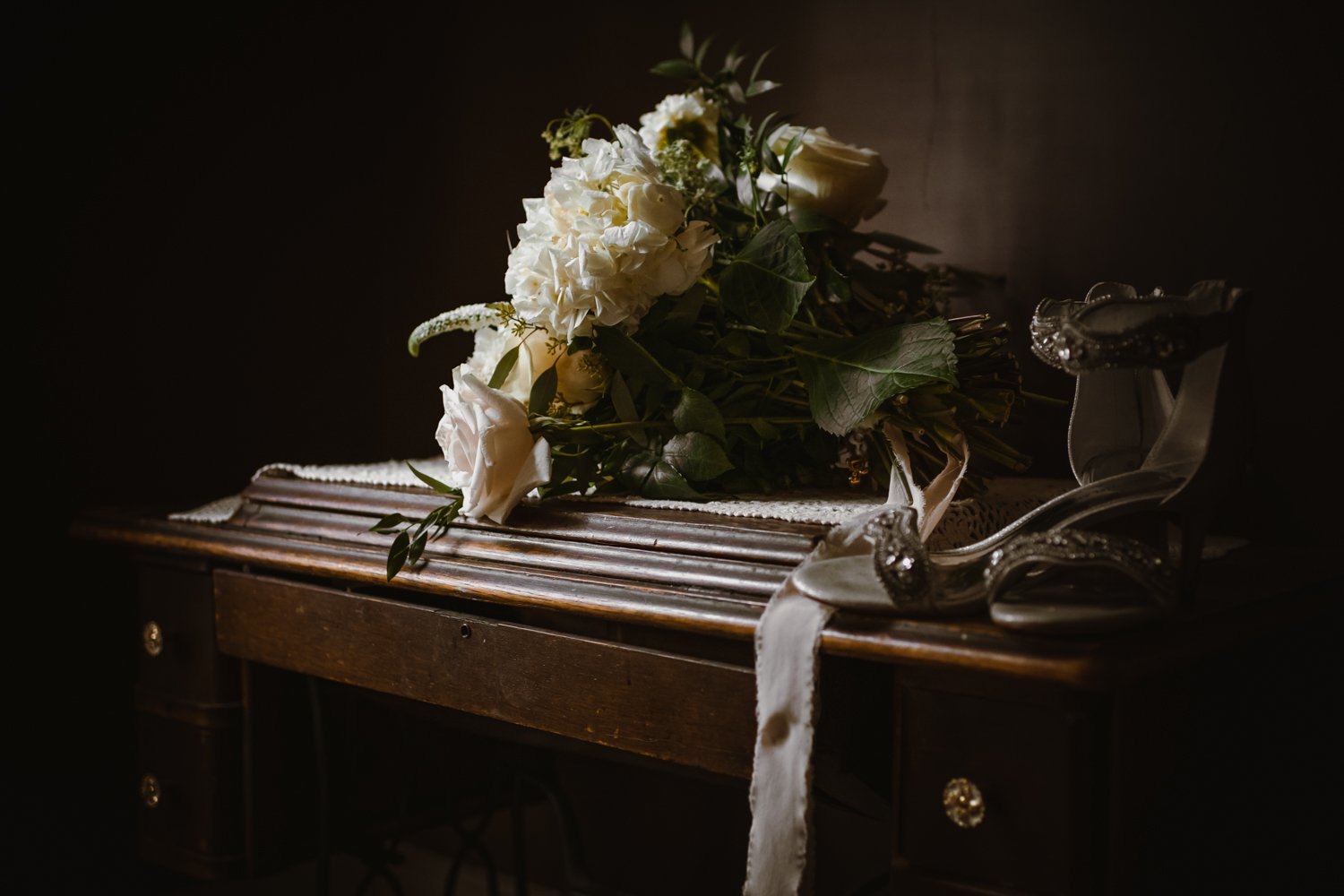Subject: Photography
Objective: Students understand the concept of the exposure triangle and its impacts on an image
Exposure
Lighting
Light is a key component to photography. Without light we would be left with little more than a black image, no colour, no depth. Understanding how light functions and how we can take advantage of it with the tools, subjects and environments available to us is critical in achieving our photographic objectives. Some situations like studio photography are controlled and offer you extended time to capture the image, while others are more time-critical like the first kiss at a wedding. What matters most in ensuring that you see success with your imagery is knowing exactly how to control the light coming into your camera.
An engagement ring set inside of a wedding band with natural window light from the side.
Sources of light
When we consider light we need to think about many factors. Things like where it comes from, how bright it is, the size of the source, what colours it’s carrying or reflecting off of, what it might be traveling through, the object(s) it’s landing on, and the nature of the light (natural or artificial). These are only a handful of the reasons we’ll be exploring, but they all impact the decisions you should be making in creating your image.
You may be dealing with one large light, two small lights in different spots or angles, or multiple lights, each with different colours, but without a doubt the effective relative size of your light source(s) to your scene and subject are the most important factors to consider and (ideally) control when capturing an image.
How do we control the light?
When it comes to cameras we have a great many things to recognize before we answer that. Firstly, not all cameras are created equal. Some have mirrors with physical movement shooting onto film or a memory card, some are fully digital, some can change lenses to offer more options objectively or creatively-speaking, and some are themselves accessory features like in cell phones!
At the core of it however, cameras all tend to operate on the same core critical concepts, and the most important pertaining to light is that of Exposure. Images rely on light landing - even incredibly briefly, on a light-sensitive film or sensor. Exposure is a term that refers to the overall amount of light which lands on the exposed photo-sensitive film or sensor to capture an image and the resulting tonal range it creates; essentially in layman’s terms it refers to the brightness/darkness of the overall final image.
How does our camera control it?
“Exposure is a term that refers to the overall amount of light which lands on the exposed photo-sensitive film or sensor to capture an image and the resulting tonal range it creates; essentially in layman’s terms it refers to the brightness/darkness of the overall final image.”
We’re going to explore this with a common industry term called the “Exposure Triangle,” which refers to three specific elements of a camera and how they can be adjusted to have different impacts on an image’s final look/exposure.
A wedding ring set inside a rose. See how the face of the ring is in focus but not the rose? That’s because I shot this at F/1.4 and it has a very shallow depth of field.
Aperture
In a proper camera lens there are a series of little blades which expand and contract to allow light through, much like the iris of an eye. The number of blades may vary, but the effect is fundamentally the same.
The Aperture not only literally determines the width of the opening letting light in to the film or sensor, but it also determines how much of the image will be sharp or blurry. The amount of the image which is deemed ‘acceptably sharp’ is referred to as DEPTH OF FIELD and is a very important concept for you to know moving forward. When there are images with very little content which is super sharp, but large parts of the image are blurry, we refer to those as having a “shallow depth of field.” When much of it is sharp we refer to those images as having a “deep depth of field.”
One thing you should consider though is that the smaller the opening that is created by the blades, the longer it would take for an image to expose. Conversely, if they’re really wide open light will flood in fast. These facts make shooting in broad daylight and low-light situations occasionally tricky.
The industry does have a standard for aperture indications and it’s actually a diameter equation: Focal length/Diameter. Most times you don’t need to understand this, but it’s a function of area because it’s not a slit measured the diameter of the opening that lets the light in, but rather the whole area! That means (you guessed it) this is actually one of those times that πr² matters in life! Because of the equation’s diameter being in the denominator, that leaves us with an inverse relationship between the size of the opening and the number. So, that means F/2.8 has a far greater opening than F/22! The wider the aperture (think F/1.4) the less that will be super sharp, meaning we would say it has a “shallow depth of field.” The narrower the aperture (think F/32) the more that will be sharp, meaning we would say the image has a “deep depth of field.”
The Exposure Triangle - The three elements which control the exposure, depth of field, blur/sharpness, and amount of noise in a photograph.
2. Shutter Speed
This refers to how long the sensor will be active (in modern digital cameras) or how long the mirror will be up and curtains exposing the film/sensor in older/more traditional SLR/DSLR cameras. This setting is also the one which determines if an image will freeze motion or show motion blur. There are instances where a person might need motion frozen - such as when a bride is walking down the aisle, and there are instances where motion blur makes a lot of sense - such as when you’re showing helicopter blades in motion, or a race car.
This photo was shot at an incredibly fast shutter speed of 1/8000th of a second, completely freezing the water droplets mid-air!
Shutter speeds are indicated in either full seconds or fractions of a second such as 1/125, 1/250, 1/500, etc. and the slower they go the blurrier the image will look. If you need the image to be sharp, then you need to ensure that you are shooting fast enough. One thing to consider when you’re shooting is that you yourself may be moving, so you might need to shoot with a fast enough shutter speed to account for those movements too - but that’s called the “reciprocal rule,” and I’ll cover that in another lesson.
An image shot at ISO 2000. Normally, if a camera were to be able to expose this at ISO 100 it would be smooth in the out of focus areas like this.
3. ISO / Film Speed
This refers to the film/sensor’s responsiveness to light. In older cameras the user would rely upon film which was set no matter what. Now we can adjust the camera’s ISO (sensor sensitivity) on the fly to adapt to whatever the situation might require. While it might sound like it’s a catch-all which compensates for when the image exposure is too dark/bright because of the aperture or shutter speed settings, it does come with the unfortunate side effect of digital noise.
You may have seen digital noise in your older photos presenting in the form of little red, green, and blue dots randomly scattered through the image. It generally represents electronic noise - a byproduct of almost every electronic circuit, and it presents as a digital “grain.” While this is something we’ll explore in another lesson in higher grades, for now it’s sufficient to view increasing it beyond a certain point as a consequential negative impact to your image quality.
You may be asking “what is the threshold for acceptable ISO before the noise becomes distracting/unbearable?” There are really too many factors to say. It might be a matter of personal preference, sensor capacity, the subject matter in the image (low-light areas tend to showcase noise a lot), and the list goes on. Your best bet is always to shoot often and gain an understanding of what to expect and how to counter it if possible. Remember, noise isn’t the end of the world! An image with some noise is better than no image at all, and many successful photographers are known to use it artistically.
Assignment
Take a look at the following link:
EXPOSURE TRIANGLE SIMULATOR
Now try adjusting the dials and watching how it effects the image in real-time. Once you start to understand how the concept works, look into your phone’s camera app to see how to set your camera to Manual Mode (you may have to download a free software from the app store). Practice taking a minimum of 15 shots featuring shallow depth of field, motion blur, and digital noise - ALL WITH A PROPER EXPOSURE. Place the images into your shared class Google Drive under a sub-folder entitled “Exposure Triangle”


